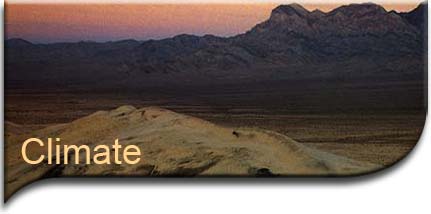|

Climate of the
Mojave Desert
The Eastern Mojave Desert is characterized by wide day–night temperature fluctuations, seasonal strong winds and bright, clear skies. Beautiful Night Skies The night sky over Soda Springs is usually cloud and smog free and excellent for several kinds of astronomical observations. Qualified individuals and groups are invited to use the Center's 11 or 18–inch reflecting telescopes. Current Weather and ForecastsAverage hourly meteorological data for the last 36 hours are available from the National Oceanic and Atmospheric Administration (NOAA) for Kelso (elevation 2005' southeast of the Center), and Mid Hills (elevation 5,413', about 40 miles east of the Center). NOAA has current conditions and forecasts for the Eastern Mojave and Las Vegas areas. Click on the desired area on the home page map. Intellicast also has current conditions and a forecast for the Baker area (Weather Station is at Daggett). Average Temperatures Since 1980 the temperature at Soda Springs has varied from a low of 8°F in January to a high of 119°F in August. Based on the analysis of W.T. Reid, the mean temperatures, averaged over a four–year period, were as follows:
Temperatures Days with temperatures in excess of 100°F typically begin in May and can last into October. During July and August minimum nocturnal temperatures in the low to mid 90s can be expected on several nights. Humidity Relative humidity is low, below 40% most of the year; above 50% on most winter nights, during precipitation and on summer evenings after a rain. On a typical summer afternoon the relative humidity is approximately 10%; on a winter afternoon, approximately 30%. Rainfall The rainfall pattern is seasonal with most rain falling between November and April. Since 1980, the mean annual precipitation has been 3.5 inches, with a minimum in 1986 of 1.5 inches and a maximum, in 1983, of 6.5 inches. However, there is a summer thunderstorm season, from July to September, during which the Soda Springs area has experienced violent and heavy rainfall, up to 2 inches in 2 hours. The driest months are May and June. Winds Winds are a prominent feature of the weather at Soda Springs in Autumn, late Winter and early Spring. Strong, substantial winds in excess of 25 mph are common, with gusts reaching 75+ mph. While wind is common in all months, November, December, and January are the calmest. Rain Event—2005 The recent rains in southern California resulted in the filling of the water supply reservoirs for most of San Diego, Orange, Riverside and San Bernardino counties. Additional rains have force the water agencies to release water from the reservoirs to make room for snow melt and any additional rains that may occur in the next month. The effects of released water from the Silverwood reservoir and the flow of water down the Mojave River resulted in a large volume of water flowing through dry river basins, causing damage to county and private infrastructure and filling some of the "lost dry lakes" of the east Mojave Desert. Rainfall data at selected sites at the source of the river and along the Mojave River and photographs of the resultant down stream flow can be viewed at the Mojave River Flood 2005. |
||||||||||||||||||||||||||||||||||||||||||||||||||||||||||||||||||